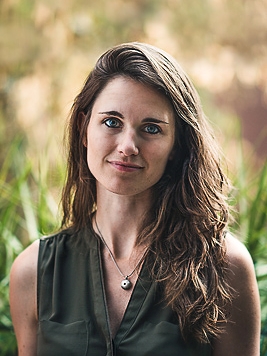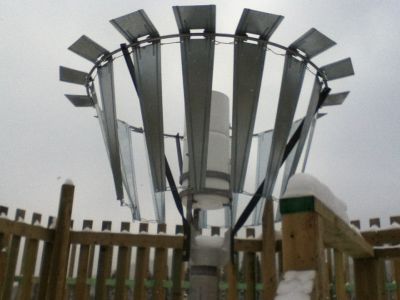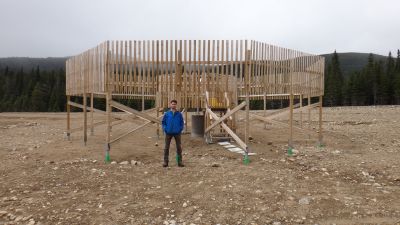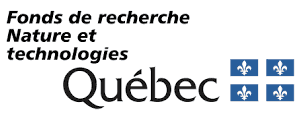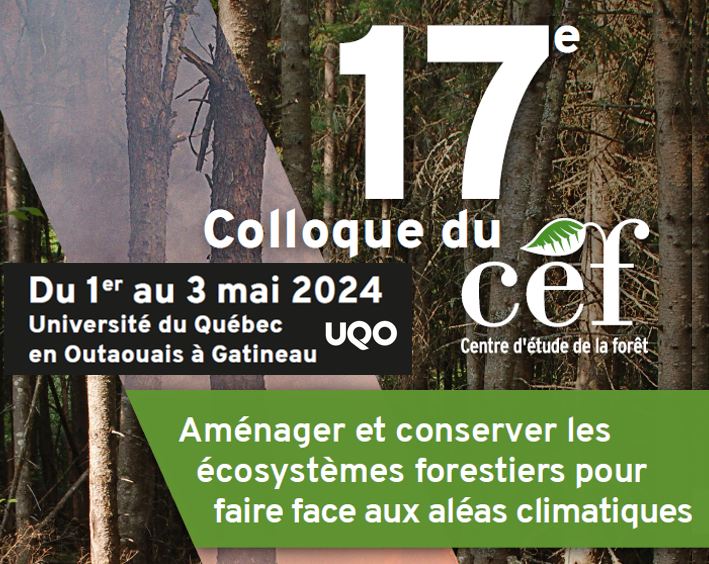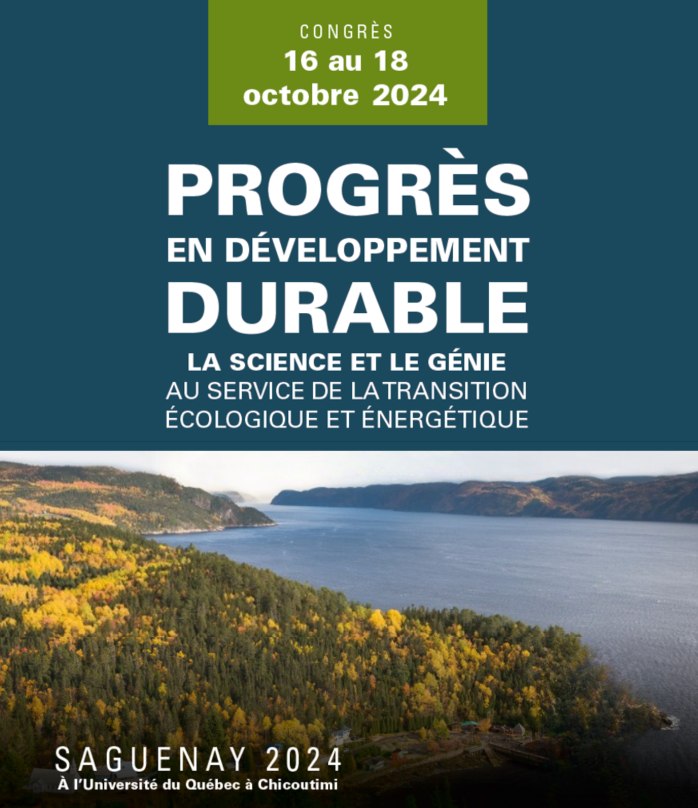NEIGE site
Vision
To promote the exceptional potential of the natural features and scientific infrastructures found at Forêt Montmorency for the study of snow through an integrative research program based on the comparison of solid precipitation measuring devices and the collaboration of institutions interested in the subject.
The abundance of snow, the accessibility of the site, its location in the heart of the Canadian Shield as well as the abundance and extent of its hydrometeorological history are among the assets of this site which could eventually compete with those of the Center for Atmospheric Research Experiments (CARE) near Egbert, Ontario, Canada, and the National Center for Atmospheric Research (NCAR) Marshall Field Site, located in Boulder, Colorado, USA.
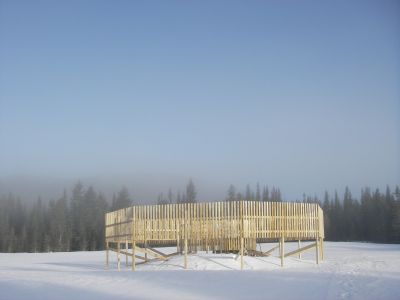
DFIR Meteorological device
Goal and main objectives pursued on the NEIGE site
The NEIGE site aims to contribute to the improvement of water supply estimation during the winter period by means of improving snow methods measurements in forest environment, in the boreal biome.
- Evaluate the daily, bi-daily and daily sub-capture of solid precipitation for different types of precipitometers and windshields installed at Forêt Montmorency.
- Develop equations using usual meteorological parameters in order to allow raw solid precipitation data to be debited according to the devices and shields used.
- To compare the efficiency of the devices estimating the water equivalent of the snow in the snowpack.
- Promote data and results sharing among stakeholders through knowledge transfer activities and thematic workshops.
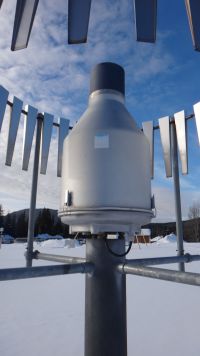
Geonor rain gauge
with Alter shield
Context of the development of the NEIGE site
Although it is recognized that under-capture is a significant source of bias in the measurement of solid precipitation, the consideration of this factor is still not standardized in the national climate monitoring networks. Since several types of solid precipitation measuring devices (snow, ice pellets, etc.) are, and have been, used across Canada, it is sometimes very difficult to obtain spatially and temporally consistent information from them. This situation is at the source of significant uncertainties, among others, when snow is an essential input for the simulation of river flows or for the simulation of snow cover in mountainous areas.
Few sites around the world can compare precipitometers with each other. Some of these sites are found in Canada, which places the country in the list of main contributors to the development initiatives of this science. Canada was actively involved in the World Meteorological Organization's (WMO-SPICE) International Precious Precipitation Comparison Program and implemented a stand-alone parallel program (C-SPICE) with similar objectives. The NEIGE site, located at Forêt Montmorency, Quebec, Canada, is currently the largest multi-institutional solid precipitations observation site in Quebec and possibly among the best equipped in Canada.
This site is supported in part by the Plan d’Action Saint-Laurent (PASL). This collaboration between the governments of Canada and Quebec is based on a set of specific projects aimed, among other things, at facilitating the sharing of hydrometeorological information. The NEIGE site is the only place where solid precipitation measuring devices complying with the measurement protocols of the two organizations (EC and MDDELCC) are deployed. That makes it an exceptional site for this type of collaboration. In addition, there are also two shields, very rare, used as international references in the study of sub-capture processes. Those are Double Fence Intercomparison Reference (DFIR) shield, allowing manual meassurments; and a similar device allowing automatic measurements, the Automatic Double Fence Reference (DFAR). For three winters (2017,2018 and 2019), measurements also took place in a special set-up mimicking a natural environment, known as a «bush gauge». In addition to the measurement of solid precipitation, several innovative commercial devices and some prototypes are installed on the NEIGE site to measure the water equivalent of snow. This data is of paramount importance in hydrology because it represents the water contained in the snow cover that will become available at the time of spring melt. The recent development of automated devices based on the attenuation of gamma radiation emitted by the ground, the alteration of the GPS signals or the variation of the mass of the snow constitutes a small revolution compared to the manual measurements carried out at great expense for decades by government agencies.
Description of the site and installed devices
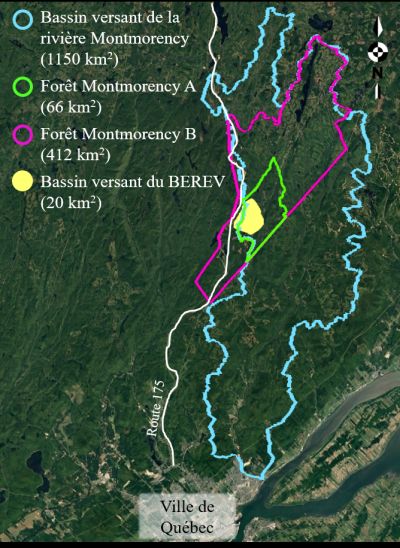
Location of the Forêt
Montmorency north of Quebec City
Forest Montmorency is a forest area of 66 km2 located about 80 km north of Quebec City, in the middle of the Canadian Shield. In 2012, an expansion extended the boundaries of its territory over 412 km2. Under the responsibility of Université Laval since 1965, this teaching and research forest has been, since its inauguration, a hot-spot for the development of meteorological and hydrological sciences. A reference meteorological station has been carefully monitored and maintained for nearly 50 years. An average of 619 mm of water equivalent was measured in solid form, making it one of Quebec's weather stations measuring the largest quantities of snow. Since February 2014, an average of 160 winter snow events have been measured, 75% of which are over 3 mm. At the Montmorency Forest, there is also the experimental watershed of the Eaux-Volées stream (BEREV), which is the oldest, measured, small-scale forested watershed in Canada. With its continuous hydrometeorological records spanning more than 50 years and the precision of its measurements, it is possible to study snow accumulation and melting processes in order to estimate the effects of debugging solid precipitation data on spring flows.
The presence of a reference instrument such as the DFIR (February 2013) is therefore the basis of the initiation of this project comparing snow measuring devices. The diversity of the institutions involved (> 5, federal and provincial) and deployed devices (> 13 snow measuring devices), the history of the site (50 years of existence in 2015), its accessibility (<80 km of Québec), as well as its abundance of snow (> 600 mm of snow per year) will establish precise empirical relationships that can then be validated by a water balance approach.
In order to demonstrate the opportunities for solid precipitation studies, here is a summary list of the infrastructures in place, as well as the institutions responsible for them. All are currently available and can be used as part of the proposed project:
- The climatic reference station of Forêt Montmorency RCS (Environment Canada):
- Thermo-hygrometer (HMP from Vaisala) in a vented Stevenson shelter,
- Anemometer (05103 from RM Young) installed 2 m high,
- Anemometer (05103 from RM Young) installed 10 m high,
- Radiometer (CM21-XT from Kipp & Zonen) measuring the full solar spectral range,
- Automatic precipitometer (T200-B from Geonor) with Alter shield,
- Automatic precipitometer with tipping bucket (CS700 from Hydrological Services),
- Three ultrasonic distance sensors measuring snow depth (SR50 from Campbell Scientific) whose arms are respectively facing:
- South,
- East,
- West
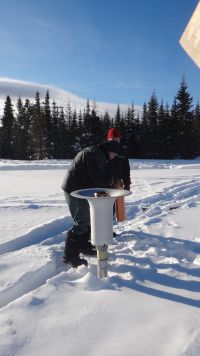
Manual Precipitometer
with Nipher shield
- The Forêt Montmorency experimental station from the «Service Info-Climat du Ministère de l’Environnement et de la Lutte contre les changements climatiques (MELCC) » :
- Thermo-hygrometer (HMP from Vaisala) in a antiradiation screen,
- Anemometer (05103 from RM Young) installed 2 m high,
- Automatic precipitometer (Pluvio² from OTT) with Alter shield,
- Automatic precipitometer (Pluvio² from OTT) without shield,
- Ultrasonic distance sensors measuring snow depth (SR50 from Campbell Scientific),
- Surveillance camera (unknown model),
- Manual copper precipitometer with Nipher shield (custom made),
- Manual copper precipitometer without shield (custom made),
- Snow ladder (custom made),
- Snow table (custom made).
- The C-SPICE station of the Forêt Montmorency (Environment Canada) located at 150 m of the RCS station. Completely deforested and laid bare in 2013, this land of nearly 1 ha is dedicated to the addition of instruments related to the study of solid precipitation :
- Thermo-hygrometer (HMP from Vaisala) in a Stevenson vented shelter,
- « Double Fence Intercomparison Reference » (DFIR) shield, which has in its center a manual precipitometer (H&H90 from FHS) with a Tretiakov shield :
- Manual precipitometer (H&H90 from FHS) with Tretiakov shield,
- Copper manual precipitometer with Nipher shield (custom made),
- «Double Fence Automated Reference» (DFAR) windshield, which has in its center an automatic precipitometer (Pluvio² from OTT) with Alter shield
- Automatic precipitometer (Pluvio² from OTT) with Tretiakov shield
- Automatic precipitometer (Pluvio² from OTT) with Double-Alter shield,
- Automatic precipitometer (T200-B from Geonor) without shield,
- Automatic precipitometer (T200-B from Geonor) with Alter shield,
- Anemomoeter (05103 from RM Young)
- Sonic 3D anemometer (CSAT-3 from LI-COR)
- Disdrometer (Parsivel² from OTT) characterizing the precipitation phase,
- Sonic 3D anemometer (WindMaster from Gill Instruments),
- Snow water equivalent sensor (CS725 from Campbell Sci.),
- Ultrasonic distance sensor measuring snow depth (SR50 from Campbell Sci.),
- Temperature probe (107BAM from Campbell Sci.) 2 m high in an antiradiation screen,
- 6 pairs of sensors inserted at different depths in the ground under the CS725,
- Soil water content (CS616 from Campbell Sci.),
- Soil temperature (107BAM from Campbell Sci.),
- Snow water equivalent sensor (SnowSense from VISTA Geosciences Gmbh),
- Mat of thermocouples measuring the temperature of snow and soil (Nadeau's lab),
- 10 chronophotographic cameras,
- Snowlines with 10 measuring stations,
- Sector dedicated to the realization of snow pits.
|
|
- The Laflamme lake meteorological station of the forest research direction of the Ministère de la forêt, de la faune et des parcs (DRF-MFFP), located less than 2 km from RCS station.
- Temperature, relative humidity, wind 2 m, solar radiation, etc.
- Automatic Belfort precipitometer with simple Alter shield,
- Ultrasonic distance sensor measuring snow depth (SR50 from Campbell Scientific).
- Snowlines describing the accumulation and melting of snow cover in forest areas measured since 1993 by the Department of Wood Science and Forest de la Faculté de foresterie, de géographie et de géomatique de l’Université Laval (FFGG-ULaval).
- Bi-monthly monitoring of the thickness and snow water equivalent of the snowpack, from January to May, for three snow lines (juvenile eastern forest, west-facing juvenile forest and mature forest).
- Hydrometeorological archives of the BEREV (FFGG-ULaval), located less than 5 km from RCS:
- Daily and hourly flows for four gauged thresholds delimiting nine sub-watersheds ranging from 120 to 920 ha,
- Chronophotographic sequences of a threshold allowing validation of under ice flows (2012 and 2014).
Attach:NEIGE_SIMAT_Table_et_échelle_400.jpg Δ | Snow table
- The archives of the Forêt Montmorency weather station (ULaval - MENV) extending from 1965 to 2003:
- Temperature, relative humidity, wind 2 m and 10 m, solar radiation, etc.
- Manual precipitometer with Nipher shield,
- Snow ladder,
- Snow table,
- Heating precipitometer with tipping bucket.
- Data from L'Étape weather station (Environment Canada), located within 30 km of the SCR station
- Temperature, relative humidity, wind 2 m, solar radiation, etc.
- Automatique precipitometre Geonor with simple Alter shield,
- Data from the MTQ weather station located less than 3 km from the RCS station
- Data from a Canadian Forest Service station related to the ECOLEAP project
- In addition, the site is covered by two meteorological radars: Villeroy and Castor lake.
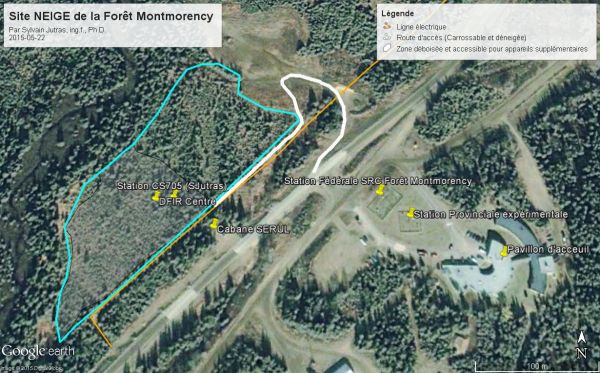
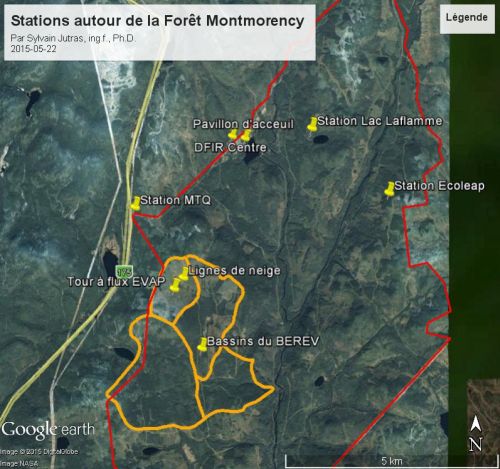
Recent history of the work of the site NEIGE
- November 2013 : Deforestation and scalping of the C-SPICE station
- December 2013 : Construction of the DFIR on the C-SPICE station
- February 3rd 2014 to April 14th 2014 : 1st winter season of manual data collection
- October 2014 : Renovation of SCR Forêt Montmorency Station by Environment Canada
- Novembre 13th 2014 to April 11th 2015 : 2nd winter season of manual data collection
- September 2015 : Construction of the bush gage on the C-SPICE station
- October 2015 :
- Electrification and leveling of the C-SPICE station,
- Renovation of the provincial experimental station by the MDDELCC
- November et December 2015 : Installation of several dozen devices on the C-SPICE station
- November 9th 2015 to March 31th 2016 : 3rd winter season of manual data collection
- Autumn 2016 : Replacement of some alder in the bush
- Autumn 2016 : Addition by ECCC of a Double-Alter shield on the C-SPICE station
- November 3rd 2016 : Beginning of the 4th winter season of manual data collection
- November 1th 2017 : Beginning of the 5th winter season of manual data collection
- November 22th 2018 : Beginning of the 6th winter season of manual data collection
- Autumn 2018 : Construction of the DFAR on the C-SPICE station
- November 4th 2019 : Beginning of the 7th winter season of manual data collection
- Autumn 2020: Installation of a camera network
- November 3th 2020 : Beginning of the 8th winter season of manual data collection.
Snow Workshop
Since one of the objectives of the Forêt Montmorency NEIGE station is to promote data and results sharing among stakeholders through knowledge transfer activities and thematic workshops, a first workshop on snow has took place on March 27 and 28, 2019 at the Forêt Montmorency. The purpose of this workshop was to promote the NEIGE site, to foster networking among the various researchers and users of snow-related data, to share research findings and to discuss future challenges and opportunities for snow research.
The workshop in pictures
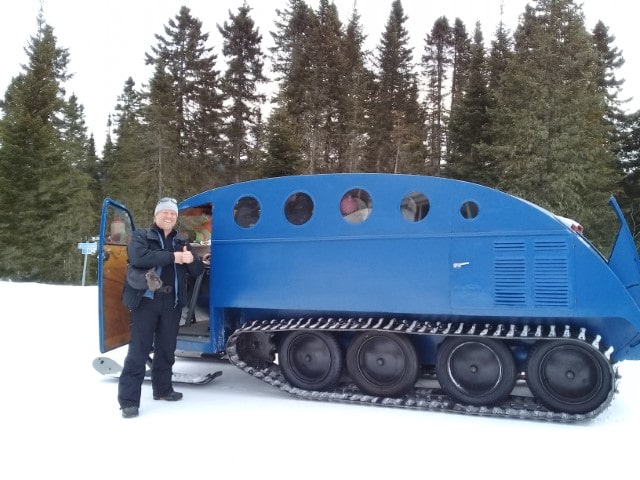 ,
, 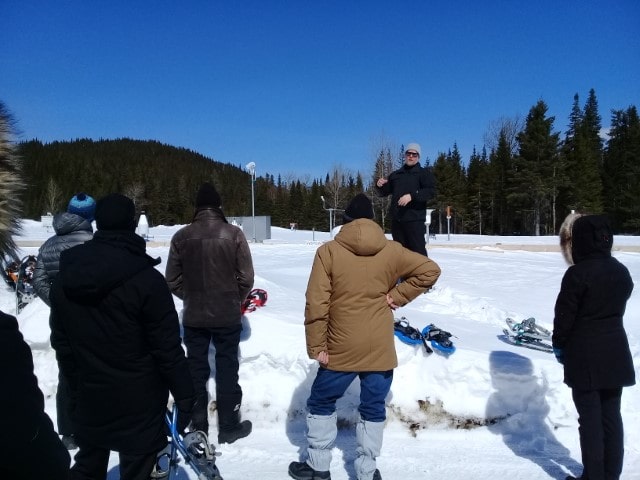 ,
, 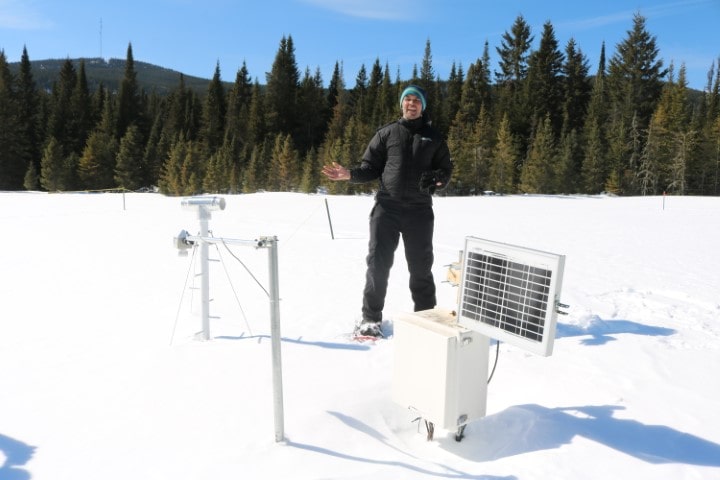 ,
, 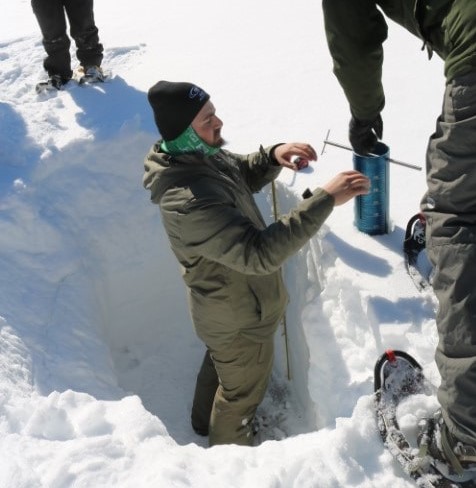 ,
, 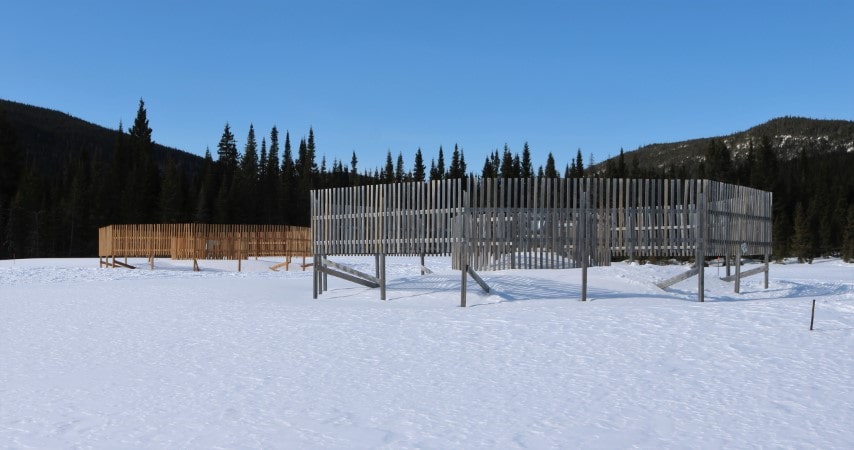 ,
, 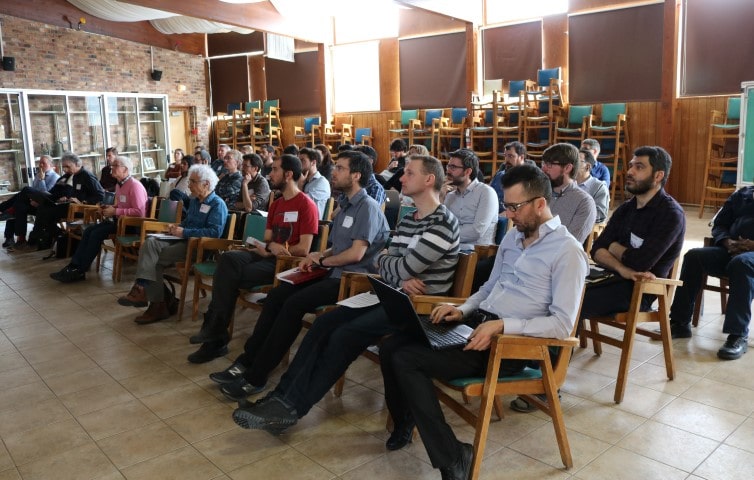 ,
, 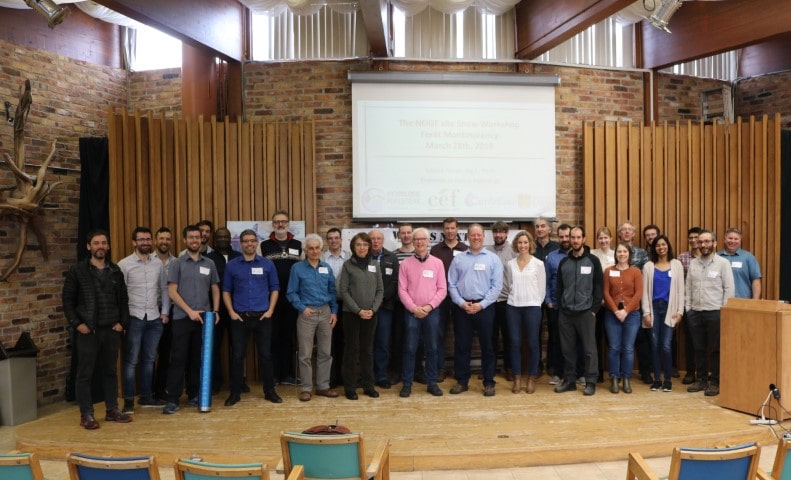
For more information, contact Sylvain Jutras, ing.f, Ph.D.
Last update: April 2019





